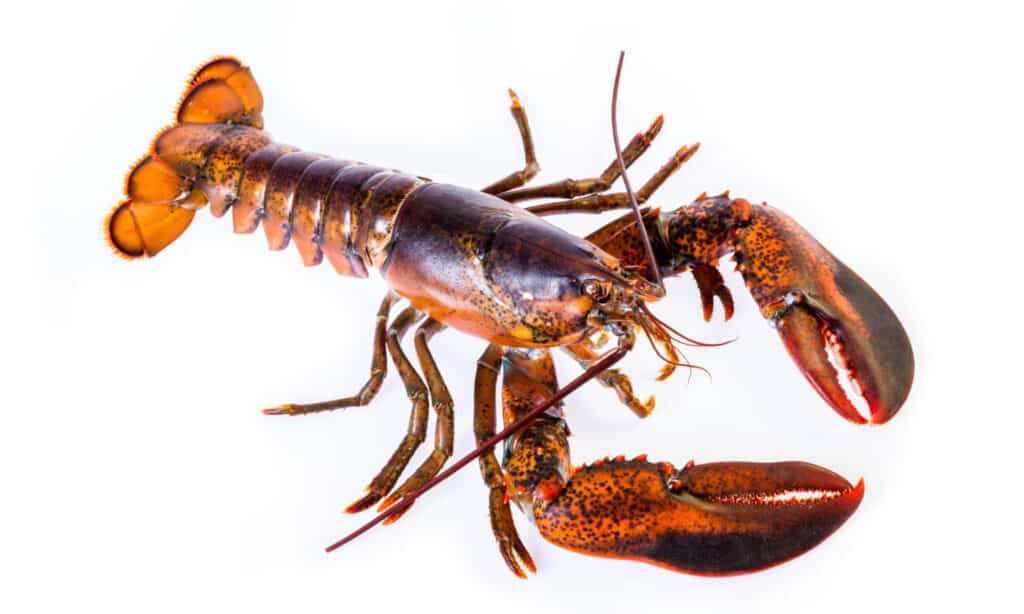Lobster is a delicacy prized for its delectable meat; it holds a premium status in luxury restaurants worldwide. As one of the costliest seafood options, lobster is a conversational focal point. Many debates surround its fishing, sale, handling, and export. With the approaching 2024 lobster market, the surge in global demand, worries about overfishing, and the effects of climate change on lobster populations raise important questions about what to expect on your plate in the coming year.
How are Lobsters Priced?

Keeping those lobsters food-safe, alive, and healthy before they hit your plate adds to the overall cost. Throw in harvesting regulations, like size requirements and conservation measures, affecting supply and pricing.
©Rada Kabanova/Shutterstock.com
The world of lobster sales has a lot of moving parts. Every step, from fishermen to processors, transporters, and sellers, plays a role in the final cost. In 2023, lobster prices ranged from around $6 to $16 per pound wholesale and $8 to $22 per pound retail, but after factoring in bait and fuel costs, lobstermen might only pocket $4 to $5 per pound.
The population of lobster was once so abundant they washed up on shores. Intense fishing to meet rising demand changed that. This led to depleted supplies and government interventions to keep lobster populations afloat. Despite all the modern tech making the journey from the ocean to your table smoother, the lobster’s story is still a complex mix of economic and environmental factors.
What is Affecting Lobster Prices?

To break the vicious cycle of over-harvesting, governments have stepped in with stringent regulations. Fishermen are now mandated to adhere to stricter size limitations on the lobsters they catch. These regulations aim to prevent the complete depletion of lobster populations, signaling a crucial intervention to sustain the delicate balance between supply and demand.
©Yellowj/Shutterstock.com
The global lobster market has experienced explosive growth in demand, with the market size reaching an impressive $7.6 Billion in 2023. Projections indicate a further surge, anticipating the market to reach $16.0 Billion by 2032. Lobster’s increasing global popularity and export throughout the world drives this surge in demand. However, the challenge lies in the fact that the few lobster habitats on Earth bear the responsibility of supplying the entire planet, with the US and Canada being the primary contributors. As lobster landings in Maine and Massachusetts decline, suppliers face mounting pressure to export more, especially with robust demand from China.
In a twist of fate, the once over-populated lobsters that practically washed up on shore now face declining numbers. Intensive harvesting has significantly decreased lobster populations, even as demand continues to soar globally. Thus, the population of young lobsters has suffered a severe setback. Their numbers have plummeted by nearly 40% in critical fishing waters off New England since 2018. This shift underscores the delicate balance between satisfying consumer appetites and preserving lobster populations for the future.
Global warming adds another layer of complexity to the lobster market dynamics. Lobster harvesters in the Cape Cod Bay area grapple with the consequences of climate change. The rising temperatures contribute to the growth of algae, intensifying ocean stratification and causing hypoxia. This lack of oxygen is forcing lobsters to migrate, leading harvesters to relocate their traps. The changing conditions present operational challenges, highlighting the far-reaching impacts of climate change on the lobster industry. As these multifaceted factors converge, the global lobster market faces a delicate balancing act between meeting soaring demand, adhering to regulations, and navigating the impacts of climate change.
Prices to expect in 2024
Despite the pressures in the modern lobster market, we should not expect to see a significant price increase. The average retail price for lobster in 2023 was around $17.67 per pound; in 2024, we should see less than a $1 increase to an average of $18.58 per pound. This can change quickly if we get a good harvest year, as prices historically fluctuate up and down from year to year.
Best Time to get Lobster

Fall is an ideal time for lobster, as fishermen land as many lobsters as in peak summer, and the lobsters have had a chance to firm up their shells while remaining exceptionally tender.
©LittlePerfectStock/Shutterstock.com
Lobster prices are more affordable in summer and fall due to increased catch rates. However, summer catches mainly consist of soft-shell lobsters, as they molt during this season. It’s best to avoid the summer months from Memorial Day to Labor Day to secure quality. Conversely, fall and winter, typically not associated with lobster season, bring higher prices but offer a thicker shell and richer flavor.
Bonus Lobster Fact
Not all lobsters are brown. One in two million is blue, one in thirty million is yellow or orange-and-black calico, and one in fifty million is split-colored. But the rarest lobster color of all? White. Only one in one hundred million are pearly white.
The photo featured at the top of this post is © Spalnic/Shutterstock.com
Thank you for reading! Have some feedback for us? Contact the AZ Animals editorial team.







